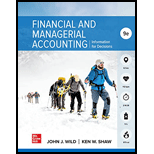
Concept explainers
Inventory:
Inventory refers to the stock or goods which will be sold in the near future and thus is an asset for the company. It comprises of the raw materials which are yet to be processed, the stock which is still going through the process of production and it also includes completed products that are ready for sale. Thus inventory is the biggest and the important source of income and profit for the business.
Perpetual Inventory System:
In perpetual inventory system there is a continuous recording of transactions as and when they take place that is purchase and sale transactions are recorded whenever they occur.
Cost of Goods Available for Sale:
It basically includes the cost of inventory which is ready for sale within an accounting period. It mainly includes the cost of beginning inventory as well as the stock purchased in that year and the production within that period (if any).
Cost of Goods Sold:
Cost of goods sold is the total expenses or the cost incurred by the business during the process of manufacturing of goods and is directly related to the production. It generally includes the cost of raw material, labor and other
Gross Profit:
The profit made after subtracting or debiting the costs related to the goods sold from the total revenue earned or made through sales in a fiscal year is the gross profit.
First in First out:
In case of first in, first out method, also known as FIFO method, the inventory which was bought first will also be the first one to be taken out.
Last in First out:
In case of last in, first out, also known as LIFO method, the inventory which was bought in the last will be taken out first.
Weighted Average Cost Method:
In this method the weighted average cost is evaluated after any purchases have been made and transactions are recorded as when purchase or sales take place.
Specific Identification Method:
Under this method, there is a continuous tracking of the inventory and the inventory cost at the time of purchase on the basis of unique identity which thus helps in the valuation of the ending inventory as well as the cost of goods sold. This method is used generally when the company is involved in limited expensive goods which are easily identifiable.
To compute: 1. Cost of goods available for sale and number of units available for sale.
2. Number of units in ending inventory.
3. Cost of ending inventory under the following methods
- (a) FIFO
(b)LIFO
(c) Weighted average
(d) Specific identification
4. Gross profit for each of the four methods in part
5. The inventory costing method suitable incase of bonus earned on gross profit.
Want to see the full answer?
Check out a sample textbook solution
Chapter 5 Solutions
FINANCIAL+MANAG.ACCT.(LOOSELEAF)-TEXT
- Accounts Receivable had a balance of $1,500 at the beginning of the month and $1,200 at the end of the month. Credit sales totaled $12,600 during the month. Calculate the cash collected from customers during the month, assuming that all sales were made on account.arrow_forwardWhat is the gross profit?arrow_forwardPlease help me solve this general accounting question using the right accounting principles.arrow_forward
- Kimberly resides in Jamaica and applied the following rules to losses carried forward in her business. Which rule was incorrectly applied? A.The deduction allowed for prior year losses (PYL) is 50 percent of the net income for the respective year. B.Prior year losses which are not utilized in the current year cannot be applied against net income of subsequent years C.Net income is the total income less all exemptions and allowable deductions excluding the specific losses. D.There is no cap on the number of years for which losses may be carried forward.arrow_forwardPlease explain the solution to this financial accounting problem with accurate explanations.arrow_forwardGive correct answer this financial accounting questionarrow_forward
- Please explain the solution to this general accounting problem with accurate principles.arrow_forwardPlease provide correct solution and accounting questionarrow_forwardWhat is the rate of return for an investor who pays $963.88 for a three-year bond with an 8.2% coupon paid annually and a face value of $1,000 and sells the bond one year later for $1,016.667?arrow_forward

 AccountingAccountingISBN:9781337272094Author:WARREN, Carl S., Reeve, James M., Duchac, Jonathan E.Publisher:Cengage Learning,
AccountingAccountingISBN:9781337272094Author:WARREN, Carl S., Reeve, James M., Duchac, Jonathan E.Publisher:Cengage Learning, Accounting Information SystemsAccountingISBN:9781337619202Author:Hall, James A.Publisher:Cengage Learning,
Accounting Information SystemsAccountingISBN:9781337619202Author:Hall, James A.Publisher:Cengage Learning, Horngren's Cost Accounting: A Managerial Emphasis...AccountingISBN:9780134475585Author:Srikant M. Datar, Madhav V. RajanPublisher:PEARSON
Horngren's Cost Accounting: A Managerial Emphasis...AccountingISBN:9780134475585Author:Srikant M. Datar, Madhav V. RajanPublisher:PEARSON Intermediate AccountingAccountingISBN:9781259722660Author:J. David Spiceland, Mark W. Nelson, Wayne M ThomasPublisher:McGraw-Hill Education
Intermediate AccountingAccountingISBN:9781259722660Author:J. David Spiceland, Mark W. Nelson, Wayne M ThomasPublisher:McGraw-Hill Education Financial and Managerial AccountingAccountingISBN:9781259726705Author:John J Wild, Ken W. Shaw, Barbara Chiappetta Fundamental Accounting PrinciplesPublisher:McGraw-Hill Education
Financial and Managerial AccountingAccountingISBN:9781259726705Author:John J Wild, Ken W. Shaw, Barbara Chiappetta Fundamental Accounting PrinciplesPublisher:McGraw-Hill Education





